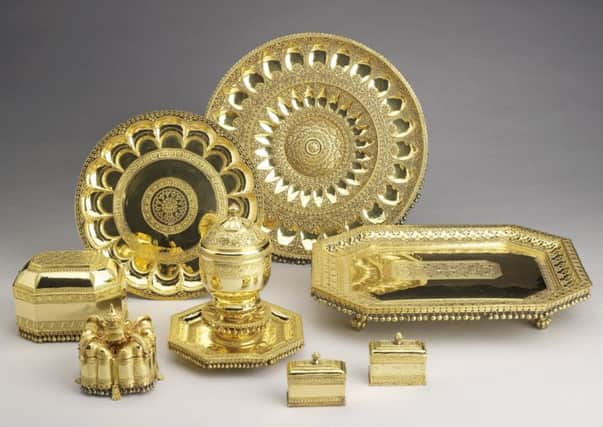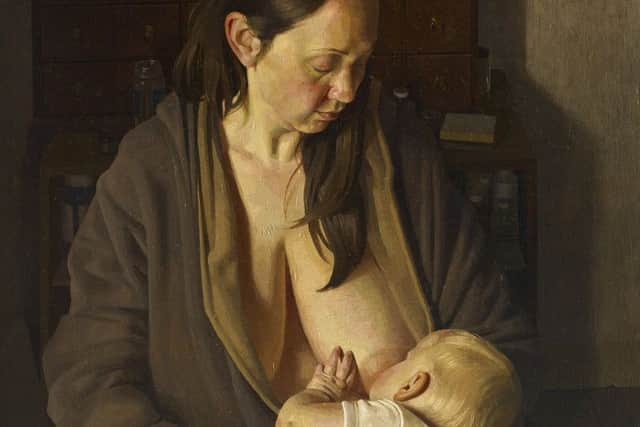Art reviews: Splendours of the Subcontinent at the Queen's Gallery | BP Portrait Award 2017, Scottish National Portrait Gallery


Splendours of the Subcontinent, Queen’s Gallery, Edinburgh ****
BP Portrait Award 2017, Scottish National Portrait Gallery, Edinburgh ***
Advertisement
Hide AdIf bling is your thing, then Splendours of the Subcontinent at the Queen’s Gallery is the show for you. Nor is this any ordinary bling. These are the gifts the Prince and Princess of Wales received on the tour that they made to India in 1875-6. It was a royal progress and in keeping with such grandeur there’s nothing fake or flashy here. Just solid gold, diamonds and precious stones, not semi-precious ones. There are occasional pieces of jade and turquoise, but mostly if it is green it is an emerald. If it is red it is a ruby. There is other stuff too of course. The enamel work is breathtaking in the skill it displays. One of the most gorgeous objects, for instance, is an inkstand in the form of a royal barge. Made of gold, its prow is a peacock. It has a peacock blue enamel breast. Its eyes are sapphires and so are the “eyes” in its tail. This enfolds the barge’s bow and the hull is also decorated in enamel and set with rubies. There is more exquisite detail in gold, silver, sapphires rubies and pearls in the fittings of the barge. Equally exquisite is an enamelled perfume holder decorated with diamonds and pearls that opens into a lotus flower. There are numerous swords and daggers with ferociously sharp looking blades of glittering steel. One dagger has three blades. Another has two dainty pistols made of gold mounted in the hilt. A walking stick made of gold conceals a working gun worthy of James Bond’s Q in its ingenuity, though far beyond him in its beauty. There is a fan of peacock’s feathers and a pair of staffs of ivory have lions’ heads with rubies for eyes. There is also fabulous jewellery that might conceivably be worn. A belt in gold encrusted with diamonds, rubies and emeralds, for instance, was presented to the Princess of Wales. Another belt in gold and enamel includes portraits of the Prince and Princess and so, like much else here, it must have been commissioned specially to be presented. In this way it showed off fabulous craftsmanship in different techniques from different regions.


It was a politically important tour. The sentiment that inspired it was expressed thus in the Times: “The greatest necessity in the government of a vast and various empire like that of England [sic] is mutual intelligence, mutual respect, a sense of unity, and increasing sympathy.” This makes more sense when at the time a large part of India was still governed by long-established Princes and Rajahs, Indian royalty in fact. The prince would be among equals in rank, although perhaps not entirely equals in wealth. The exchange of gifts, so much part of Indian princely ceremony, was going to be a tricky matter and in it the Prince would definitely be at a disadvantage. Even though his mother claimed to be Empress of India, he couldn’t possibly hope to match the lavishness of the gifts he was likely to receive from his royal hosts. To prevent embarrassment Lord Northbrook, Viceroy of India at the time, suggested tactfully to the Indian rulers that they should only present “curiosities, ancient arms and specimens of local manufacture.” The shabby practice adopted by the East India Company that ruled in British India of selling princely gifts and using the proceeds to buy the return present was considered, but happily was deemed unsuitable. This was fortunate for the Prince’s good name, but also for us as it means we can now enjoy these extraordinary treasures. This, however, is not the first time they have been seen here. After the Prince’s return, they were seen by more than a million people on exhibition in London. They were then sent on a nationwide tour that included Edinburgh, Glasgow and Aberdeen and so were seen by many thousands more. In Aberdeen, surplus funds from admissions went towards the building of Aberdeen Art Gallery.
On a present day tour, but rather less romantic, is the BP Portrait Award 2017 exhibition, which is having its annual airing. I confess I always find it just a little depressing. It is not that it is lacking in talent, more that it suggests that when it comes to portraiture artists have lost their way. This is understandable. Painting and photography have been in a close relationship since the very beginning when the painter DO Hill helped pioneer photography as an art and also demonstrated brilliantly its suitability for portraiture. Even so, while photography remained black and white and limited in scale, it didn’t supplant painting. Now though, if only quite recently, photography has moved into that territory. It can now deploy both colour and scale as effectively as painting and that seems to have left painters at a loss. Their most common response has been, if you can’t beat them, join them: paint a photograph. Some painters add fancy brushwork to cover up what they are doing, but it never convinces. Indeed sometimes the result is quite unsettling. Emma by Anthony Williams, for instance, has won third prize. It is a bust-length portrait of a naked woman painted in egg tempera. It is quite forceful, but the pattern of small raised brushstrokes which describe her flesh is a quite unpleasant. Second prize winner, Thomas Ehretsmann’s Double Portrait – mysteriously so called although it represents a girl on her own – is more successful, although
it could perfectly well be a photograph.
Martin Burdon’s monochrome portrait of Matt Berry is manifestly a black and white photograph, but like Anthony Williams’s picture his attempt to give it an unphotographic texture has a disturbing effect. Others are more successful however. Madeline Fenton has used tempera for Cecilia, a small close-up of the face of a child. The texture is smooth but not simply photographic. Others, too, seem to return for inspiration to the refined, close focus and delicate finish of early Renaissance painting. This is true of Sarah by Raoof Haghighi, a bust length of a girl against patterned wallpaper and even more strikingly


of At End of Summer by Marco Venturo. This also a bust length, but of a girl in profile. Naked, she is set against the leaves and fruit of a fig tree. The painter makes a reference to Eve, but the picture recalls Giorgione’s Laura.
First prize goes to Benjamin Sullivan’s Breech! It is a painting of his wife feeding their child. It’s was a breech birth apparently, hence the title. The picture is beautifully drawn, certainly, but looks back rather too obviously to Stanley Spencer in its composition and graphic detail. There are some pictures that do succeed as paintings, however. Sopio Chkhikvadze’s portrait of David Wigg and Nikki by John Borowicz both have the essential sense that a painted portrait is the result of an exchange. Both sitter and artist are somehow present in the finished product. This can never really be the case with a photograph. There is still room, therefore, for the painters if they forget photography and focus on what painting can really do best.
Splendours of the Subcontinent until 22 April; BP Portrait Award until 11 March